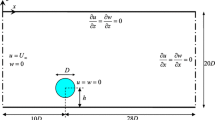Abstract
This paper considers the joint motion of an ideal fluid and a circular cylinder completely immersed in it at small times. It is assumed that the cylinder, which was initially at rest, moves in a horizontal direction with a constant acceleration. The dynamics of the internal and external free boundaries of the fluid at small times is studied. An asymptotic analysis of the form of the internal free surface near the separation points is performed. It is shown that at high acceleration of the circular cylinder, a large cavity is formed behind, with a strong perturbation of the external free surface of the fluid over the surface of the cylinder.
Similar content being viewed by others
References
L. I. Sedov, Plane Problems of Hydrodynamics and Aerodynamics (Nauka, Moscow, 1966) [in Russian].
P. A. Tyvand and T. Miloh, “Free-Surface Flow due to Impulsive Motion of a Submerged Circular Cylinder,” J. Fluid Mech. 286, 67–101 (1995).
P. A. Tyvand and M. Landrini, “Free-Surface Flow of a Fluid Body with an Inner Circular Cylinder in Impulsive Motion,” J. Eng. Math. 40, 109–140 (2001).
A. A. Korobkin and A. Iafrati, “Hydrodynamic Loads during Initial Stage of Floating Body Impact,” J. Fluids Structures 21, 413–427 (2005).
J. L. Lions, Optimal Control of Systems Governed by Partial Differential Equations (Springer-Verlag, Berlin, 1971).
M. V. Norkin, “Separation Impact of a Circular Disk Floating on the Surface of an Ideal Incompressible Fluid of Finite Depth,” Izv. Ross. Akad. Nauk, Mekh. Zhidk. Gaza, No. 1, 120–132 (2008).
M. V. Norkin, “Separation Impact of a Circular Disk Floating on the Surface of an Ideal Incompressible Fluid of Infinite Depth,” Prikl. Mekh. Tekh. Fiz. 50(4), 76–86 (2009) [Appl. Mech. Tech. Phys. 50 (4), 607–616 (2009)].
M. V. Norkin “Separation Impact of a Circular Disk Floating on the Surface of an Ideal Incompressible Exponentially-Stratified Fluid,” Izv. Vyssh. Uchebn. Zaved., Sev-Kavk. Region, Estestv. Nauki, Special issue, 168–173 (2009).
M. Yu. Zhukov and E. V. Shiryaev, Using the FreeFem++ Finite Element Software for the Problems of Hydrodynamics, Electrophoresis, and Biology (Izd. Yuzhn. Federal. Univ., Rostov-on-Don, 2008) [in Russian].
Author information
Authors and Affiliations
Corresponding author
Additional information
Original Russian Text © M.B. Norkin.
__________
Translated from Prikladnaya Mekhanika i Tekhnicheskaya Fizika, Vol. 53, No. 4, pp. 74–82, July–August, 2012.
Rights and permissions
About this article
Cite this article
Norkin, M.B. Formation of a cavity in the initial stage of motion of a circular cylinder in a fluid with a constant acceleration. J Appl Mech Tech Phy 53, 532–539 (2012). https://doi.org/10.1134/S0021894412040074
Received:
Published:
Issue Date:
DOI: https://doi.org/10.1134/S0021894412040074




